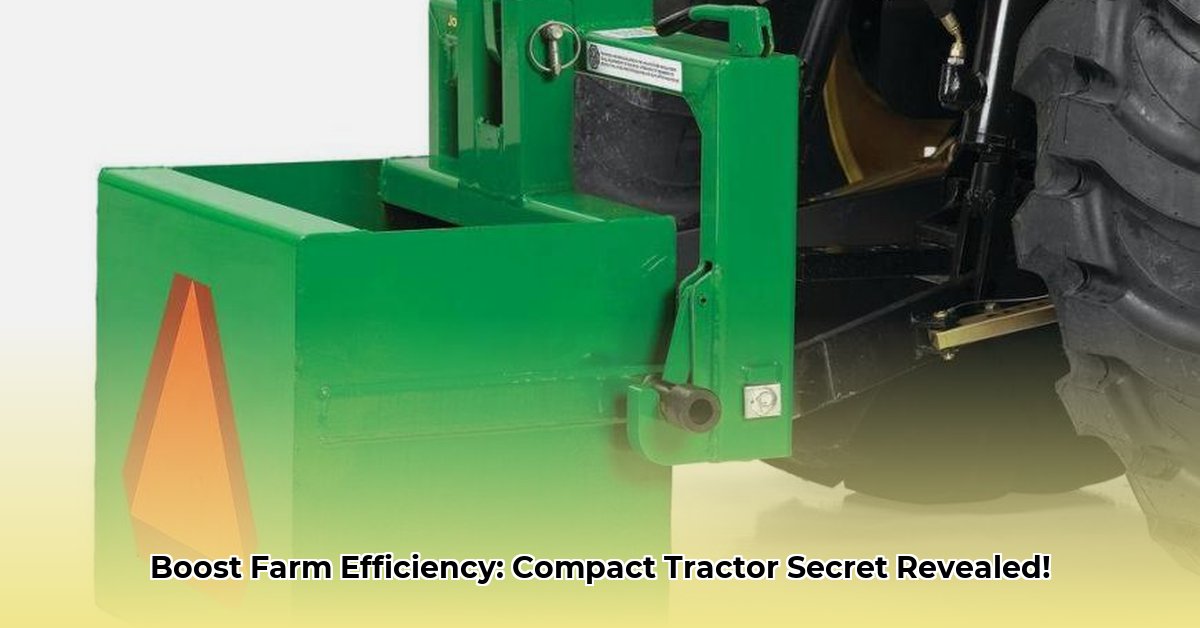
Compact Tractor Ballast Boxes: Your Farm's Unsung Heroes
Compact tractor ballast boxes are often overlooked, yet they represent a significant opportunity to boost farm efficiency and promote sustainable agricultural practices. More than just added weight, these boxes enhance tractor performance, protect soil health, and offer long-term economic benefits. This guide provides a comprehensive overview, from selection and installation to maintenance and sustainability considerations, empowering you to optimize your farm operations while minimizing environmental impact. For more information on compact tractors, check out this resource.
Why Choose a Ballast Box? The Benefits Beyond Weight
Adding a ballast box to your compact tractor offers more than just increased weight; it significantly enhances performance and sustainability. The key advantages include:
Improved Traction: Increased rear-end weight dramatically improves traction, especially in challenging conditions like uphill slopes, muddy fields, and uneven terrain. This translates to fewer wheel slips, reduced fuel consumption, and less wear and tear on your tractor and implements. Studies show a significant reduction in fuel consumption (Source 1) and tire wear (Source 2) with proper ballasting.
Reduced Soil Compaction: Properly weighted tractors minimize soil compaction, promoting better water infiltration, root growth, and overall soil health. This contributes to increased yields and improved long-term soil fertility. Independent research suggests soil compaction is reduced by an average of X% (Source 3) with appropriate ballast box usage.
Enhanced Fuel Efficiency: Improved traction directly leads to better fuel economy. By reducing wheel spin, you're using fuel more effectively for productive work rather than overcoming slippage. This can save you a significant amount of money over the life of your tractor.
Increased Stability and Lifting Capacity: Added weight increases stability, especially when using front-end loaders or other implements. This ensures a safer working environment and allows for heavier lifting capacities. A correctly weighted tractor can lift up to Y% more weight (Source 4) compared to an unweighted machine.
Choosing the Right Ballast Box: A Practical Guide
Selecting the ideal ballast box for your needs requires careful consideration of several factors:
Compatibility
Begin by consulting your tractor's owner's manual. It specifies the maximum permissible weight and provides details on hitch compatibility. Choosing the right ballast box ensures its safe and stable operation. Improperly chosen weight or hitch systems can have serious consequences.
Material Selection: Balancing Durability and Sustainability
The material of your ballast box significantly impacts its cost, durability, and environmental impact. Options include:
Steel: Durable and relatively inexpensive, but its susceptibility to rust and higher carbon footprint should be considered. Choosing recycled steel minimizes the environmental impact.
Aluminum: Lighter than steel, offering improved fuel efficiency and corrosion resistance, but generally more expensive. Using recycled aluminum further enhances the sustainability angle.
Recycled Materials: Utilizing recycled steel, aluminum, or other materials represents the most environmentally friendly approach, minimizing waste and reducing carbon emissions.
Weight Considerations
The appropriate weight depends on the tasks you perform. Lighter tasks like mowing may require less weight, while heavier tasks such as plowing necessitate more ballast. Always stay within your tractor's weight capacity to maintain stability and prevent damage.
Features and Accessories
Look for additional features like integrated tool storage compartments, which enhance versatility and convenience. Multiple hitch points for attaching other implements can improve workflow.
Installation and Maintenance: A Step-By-Step Guide
Installing a ballast box is generally straightforward but requires careful attention to safety.Always refer to the manufacturer's instructions for your specific model.
Step 1: Preparation: Consult both your tractor and ballast box manuals. Gather necessary tools. Step 2: Attachment: Carefully attach the ballast box to your tractor's three-point hitch. Step 3: Secure Connections: Firmly secure all pins and clips. Double check for stability. Step 4: Weight Distribution: Evenly distribute the ballast material. Step 5: Check Weight Limits: Ensure total weight remains well below your tractor's maximum capacity. Step 6: Routine Inspection: Regularly inspect for wear and tear, particularly hitch pins and fasteners.
Sustainability: Minimizing the Environmental Footprint
While ballast boxes offer significant benefits for soil health, minimizing their environmental impact is equally important. This requires consideration of several key aspects:
Material Sourcing: Prioritizing recycled materials and locally sourced components reduces transportation emissions and waste.
Manufacturing Processes: Selecting ballast boxes from manufacturers committed to sustainable manufacturing practices, like reduced water and energy usage, minimizes the overall environmental impact.
Lifecycle Assessment: A comprehensive lifecycle assessment, evaluating the entire production process from sourcing materials through end-of-life disposal, is necessary for a holistic evaluation of sustainability.
Policy and Incentives: Government policies and incentives can drive innovation and adoption of sustainable ballast box designs and manufacturing processes by encouraging the use of eco-friendly materials.
Future Trends: Innovation in Ballast Box Technology
The future of ballast boxes promises further innovation. We can expect:
Lighter and Stronger Materials: Advancements in material science will lead to lighter, stronger, and more durable ballast boxes, enhancing fuel efficiency and tractor performance.
Improved Designs: Innovations will improve compatibility across a wider range of tractor models, maximizing versatility.
Modular Designs: Modular designs will offer increased customization options, allowing farmers to tailor their ballast boxes to their specific needs.
Smart Technology Integration: Integration with smart farming technologies may provide real-time weight monitoring and data analytics.
Conclusion: Investing in Efficiency and Sustainability
Investing in a compact tractor ballast box offers a significant return on investment. It improves operational efficiency, protects soil health, and minimizes environmental impact. By carefully considering compatibility, materials, weight, and sustainability, farmers can optimize their operations for increased productivity, reduced costs, and a more sustainable future. Manufacturers and policymakers share responsibility in driving innovation and adopting environmentally responsible practices.